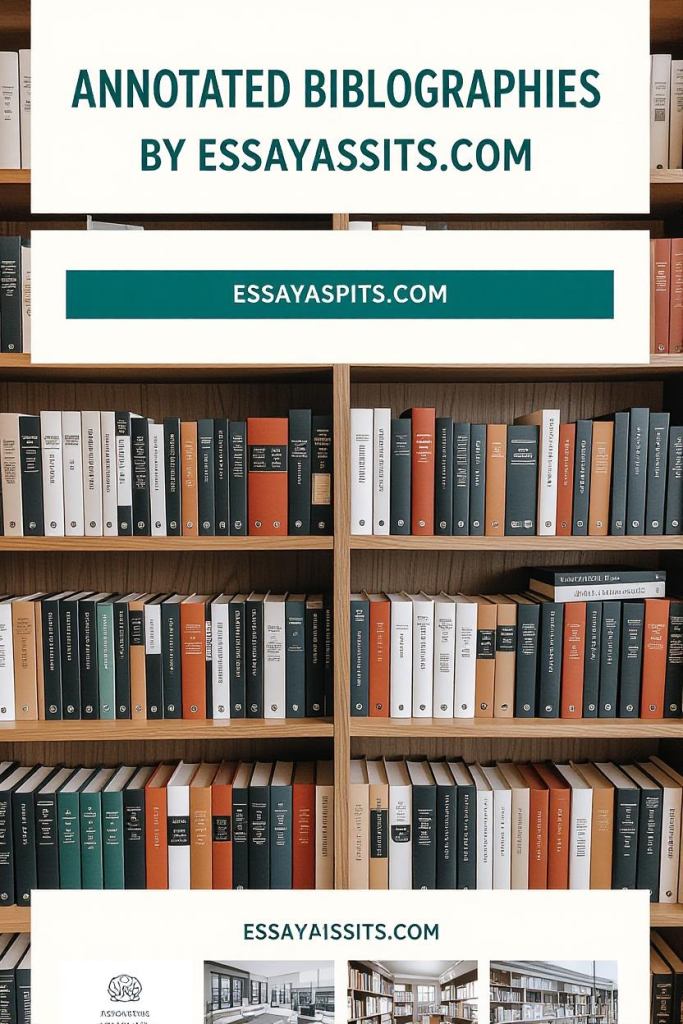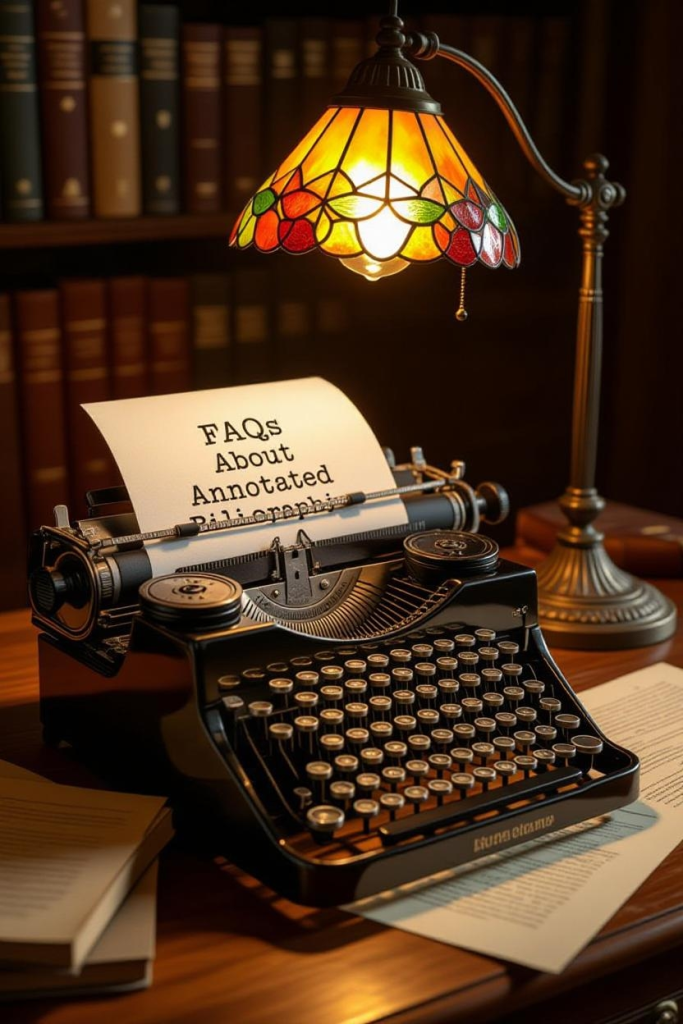
Updated October 2025
Written by EssayAssists.com Writing Experts
When you’re writing a research paper, dissertation, or academic project, an annotated bibliography helps you keep track of your sources while demonstrating your understanding of the topic. But what exactly is it—and how do you write one correctly? Let’s break it down step by step.
🔍 What Is an Annotated Bibliography?
An annotated bibliography is a list of sources (books, articles, websites, etc.) that includes a brief description or evaluation of each source.
It’s more than a standard reference list—it summarizes the content, relevance, and credibility of each source to your research.
Each entry typically includes:
- Citation: Follows a specific format (APA, MLA, or Chicago).
- Annotation: A short paragraph (usually 150–200 words) describing and evaluating the source.
📌 Purpose of an Annotated Bibliography
An annotated bibliography is more than just a list of sources—it serves several important purposes in academic research and writing:
- Organizes Your Research
- It helps you keep track of all the books, articles, and other sources you consult.
- Each annotation summarizes the source, so you can quickly recall what it’s about without rereading the entire text.
- Evaluates Sources for Credibility
- Writing annotations encourages you to assess the reliability and relevance of each source.
- This ensures your paper is supported by credible and high-quality references.
- Demonstrates Understanding of the Topic
- Annotations require you to paraphrase and summarize the source.
- This shows your instructor that you comprehend the material and can critically analyze it.
- Supports Your Research and Writing
- An annotated bibliography helps you identify which sources are most useful for your argument.
- It can guide the structure of your paper or project by showing connections between different sources.
- Highlights Gaps in Research
- By reviewing multiple sources, you may notice areas that need further study.
- This can help you refine your research questions or approach.
- Enhances Academic Integrity
- Properly documenting sources prevents plagiarism.
- Annotations show you are engaging ethically with other scholars’ work.
In short: An annotated bibliography organizes your research, evaluates sources, demonstrates your understanding, and strengthens the overall quality and credibility of your academic work.
Perfect! Here’s a complete blog-ready guide for writing an annotated bibliography, including examples in APA, MLA, and Chicago style:
🧩 Step-by-Step: How to Write an Annotated Bibliography

Step 1: Choose Your Sources Carefully
- Pick credible sources: academic journals, books, government reports, and reputable websites.
- Ensure relevance to your research topic
Step 2: Cite the Source Correctly
- Follow the required citation style (APA, MLA, or Chicago).
- Start with the full citation for each source.
Step 3: Write the Annotation
A proper annotation includes:
- Summary – Main ideas or arguments.
- Evaluation – Reliability, credibility, methodology, and significance.
- Reflection/Application – How the source supports your research or connects to other sources.
Step 4: Format Your Annotated Bibliography
- Use a hanging indent for citations.
- Indent annotations one paragraph below the citation.
- Double-space the entire bibliography.
Step 5: Review and Revise
- Check citation style consistency.
- Ensure annotations are clear, concise, and informative.
- Proofread for grammar and formatting errors.
📚 Examples of Annotated Bibliographies

APA Style
Citation:
Smith, J. (2023). The effects of climate change on urban development. Journal of Environmental Studies, 12(3), 45–59.
Annotation:
This article explores how climate change affects urban planning and infrastructure. Smith uses statistical data and case studies from major U.S. cities, making the study credible and relevant. This source supports my argument about the importance of sustainable architecture in modern cities.
MLA Style
Citation:
Smith, John. “The Effects of Climate Change on Urban Development.” Journal of Environmental Studies, vol. 12, no. 3, 2023, pp. 45–59.
Annotation:
Smith examines the impact of climate change on urban planning, using case studies and empirical data from U.S. cities. The article is reliable and provides valuable insights for research on sustainable urban development. This source will help support arguments about modern city planning challenges.
Chicago Style
Citation:
Smith, John. “The Effects of Climate Change on Urban Development.” Journal of Environmental Studies 12, no. 3 (2023): 45–59.
Annotation:
This study analyzes how climate change influences urban infrastructure. Using statistical evidence and multiple case studies, Smith offers a credible and thorough examination of urban development challenges. This source is particularly useful for discussions on sustainable architecture in contemporary cities.
💡 Pro Tips for Success
- Keep each annotation 150–200 words.
- Stay objective; critically evaluate sources rather than just summarizing.
- Use tools like Zotero, Mendeley, or BibMe to organize citations, but always double-check formatting.
- Combine sources in your bibliography that support, contrast, or complement each other for a stronger research foundation.
✅ Final Thoughts
An annotated bibliography is a powerful tool to organize your research, evaluate sources, and strengthen your academic work. Whether you are working on a research paper, thesis, or dissertation, mastering this skill demonstrates diligence, critical thinking, and academic integrity.
For expert help with your annotated bibliography or other academic writing tasks, visit EssayAssists.com and get professional support tailored to your needs.
If you like, I can also create a visually engaging infographic version of this guide that shows all 5 steps and examples in one image, perfect for sharing on a blog or social media. This usually increases reader engagement. Do you want me to do that?
🧩 Example of an Annotated Bibliography (APA Format)
Brown, L. (2024). Education and digital transformation. Educational Technology Review, 18(2), 115–130.
Brown discusses how digital tools have reshaped higher education. The article is supported by recent data and case studies, making it useful for understanding online learning trends. I will use this source to support my discussion on e-learning challenges in modern universities.
Khan, R. (2023). Social media and student productivity. Journal of Behavioral Studies, 10(1), 22–35.
This study examines the relationship between social media use and academic performance among students. Although it has a limited sample size, the findings are relevant to my paper on digital distractions in education.
❓FAQs About Annotated Bibliographies

1. How long should an annotation be?
About 150–200 words, depending on your instructor’s guidelines.
2. Do I need to include both summary and evaluation?
Yes. Most annotated bibliographies include both to show comprehension and critical thinking.
3. What’s the difference between an annotated bibliography and a literature review?
An annotated bibliography lists and evaluates sources individually. A literature review synthesizes and connects them to show research trends or gaps.
🧭 Final Thoughts
Writing an annotated bibliography is one of the best ways to organize your research, show academic integrity, and strengthen your paper.
If you’re unsure how to format or structure it properly, experts at EssayAssists.com can help you craft a perfect annotated bibliography tailored to your subject and citation style.
